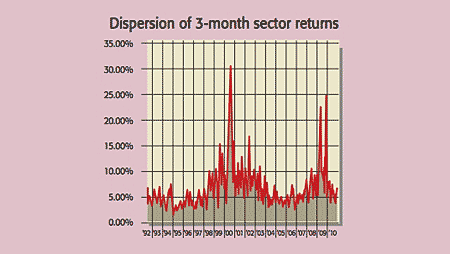Funds: Buy sectors, not whole markets
Investing in industry sector funds is a better way to get a diversified equity portfolio than just selecting broad market benchmarks, says Paul Amery.

When putting together a portfolio of equity exchange-traded funds (ETFs), many investors think no further than country indices: the FTSE 100, CAC 40, S&P 500, and so on. But they may not be investing in the most efficient way, say researchers at French business school Edhec. Investing in industry sector funds is a better way to get a diversified equity portfolio than just selecting broad market benchmarks, they argue.
In Europe, there's an increasingly popular range of 19 sector ETFs based on the Stoxx 600 Index, which includes stocks from 18 countries across the region. A Stoxx 600 oil and gas ETF will get you exposure to BP, Total, Shell, BG, Italy's ENI and Norway's Statoil in one swoop. All major ETF providers offer their own versions, but only db x-trackers has the full range listed in London (these should be capital-gains tax-eligible as they have all applied for or received 'distributor' status but do check).
So how do you go about choosing which sectors to buy? The first comparison to make is between more cyclical, economically sensitive sectors and those that have more defensive characteristics. Over the last year, according to a report on the iShares website ('Trading European Sectors'), banks and basic resources unsurprisingly have been the most volatile sectors. At the other end of the scale, the healthcare and food and beverage sectors have shown less than half the volatility of banks. These two sectors also have a lower correlation to overall market movements, which is attractive if you're looking for diversification.
MoneyWeek
Subscribe to MoneyWeek today and get your first six magazine issues absolutely FREE

Sign up to Money Morning
Don't miss the latest investment and personal finances news, market analysis, plus money-saving tips with our free twice-daily newsletter
Don't miss the latest investment and personal finances news, market analysis, plus money-saving tips with our free twice-daily newsletter

It's also worth keeping an eye on the dispersion of sector returns. This is the extent to which performance in one area of the market is not being replicated elsewhere. iShares' report shows that the dispersion of returns hit a high in both 2000 and 2008 the two occasions when a single sector dominated the market (technology shares in 2000, then banks in 2008). Apart from signalling that this can be a good time to switch from the dominant sector into less-favoured ones, such imbalances can often signal that an overall market turning point is near. For those who believe a particular sector is heading for a fall, db x-trackers also offers short (inverse) ETFs on nine of the Stoxx 600 indices, including all the most traded ones. These come at a slightly higher annual fee (0.5%, compared to 0.3% for the long versions).
Paul Amery edits www.indexuniverse.eu
Get the latest financial news, insights and expert analysis from our award-winning MoneyWeek team, to help you understand what really matters when it comes to your finances.
Paul is a multi-award-winning journalist, currently an editor at New Money Review. He has contributed an array of money titles such as MoneyWeek, Financial Times, Financial News, The Times, Investment and Thomson Reuters. Paul is certified in investment management by CFA UK and he can speak more than five languages including English, French, Russian and Ukrainian. On MoneyWeek, Paul writes about funds such as ETFs and the stock market.
-
 The graphene revolution is progressing slowly but surely
The graphene revolution is progressing slowly but surelyEnthusiasts thought the discovery that graphene, a form of carbon, could be extracted from graphite would change the world. They might've been early, not wrong.
-
 How Javier Milei led an economic revolution in Argentina
How Javier Milei led an economic revolution in ArgentinaFollowing several setbacks, Argentine president Javier Milei's pro-market reforms have been widely endorsed in a national poll. Britain will need the same
